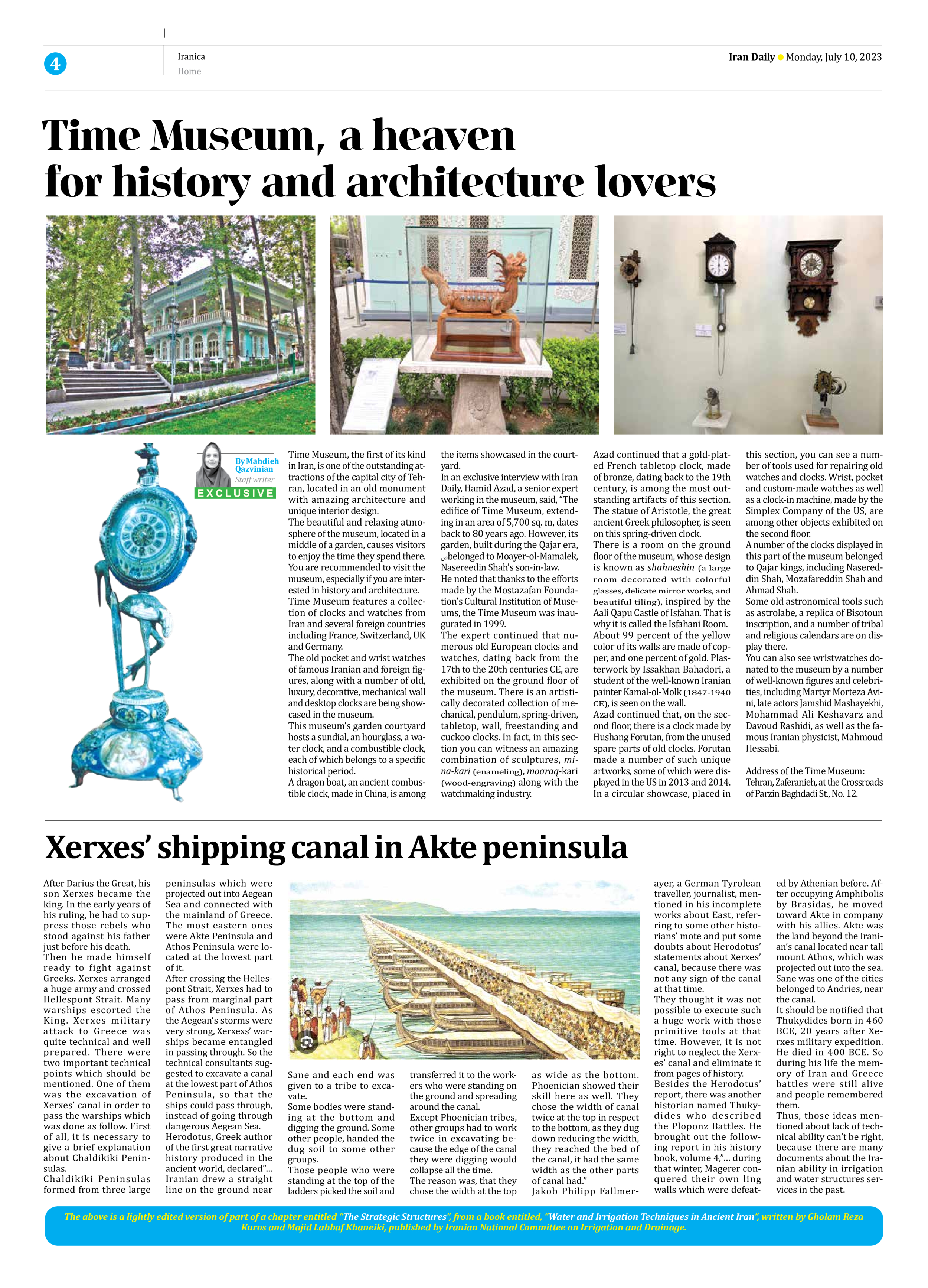
Time Museum, a heaven for history and architecture lovers
By Mahdieh Qazvinian
Staff writer
Time Museum, the first of its kind in Iran, is one of the outstanding attractions of the capital city of Tehran, located in an old monument with amazing architecture and unique interior design.
The beautiful and relaxing atmosphere of the museum, located in a middle of a garden, causes visitors to enjoy the time they spend there. You are recommended to visit the museum, especially if you are interested in history and architecture.
Time Museum features a collection of clocks and watches from Iran and several foreign countries including France, Switzerland, UK and Germany.
The old pocket and wrist watches of famous Iranian and foreign figures, along with a number of old, luxury, decorative, mechanical wall and desktop clocks are being showcased in the museum.
This museum’s garden courtyard hosts a sundial, an hourglass, a water clock, and a combustible clock, each of which belongs to a specific historical period.
A dragon boat, an ancient combustible clock, made in China, is among the items showcased in the courtyard.
In an exclusive interview with Iran Daily, Hamid Azad, a senior expert working in the museum, said, “The edifice of Time Museum, extending in an area of 5,700 sq. m, dates back to 80 years ago. However, its garden, built during the Qajar era, صbelonged to Moayer-ol-Mamalek, Nasereedin Shah’s son-in-law.
He noted that thanks to the efforts made by the Mostazafan Foundation’s Cultural Institution of Museums, the Time Museum was inaugurated in 1999.
The expert continued that numerous old European clocks and watches, dating back from the 17th to the 20th centuries CE, are exhibited on the ground floor of the museum. There is an artistically decorated collection of mechanical, pendulum, spring-driven, tabletop, wall, freestanding and cuckoo clocks. In fact, in this section you can witness an amazing combination of sculptures, mina-kari (enameling), moaraq-kari (wood-engraving) along with the watchmaking industry.
Azad continued that a gold-plated French tabletop clock, made of bronze, dating back to the 19th century, is among the most outstanding artifacts of this section. The statue of Aristotle, the great ancient Greek philosopher, is seen on this spring-driven clock.
There is a room on the ground floor of the museum, whose design is known as shahneshin (a large room decorated with colorful glasses, delicate mirror works, and beautiful tiling), inspired by the Aali Qapu Castle of Isfahan. That is why it is called the Isfahani Room.
About 99 percent of the yellow color of its walls are made of copper, and one percent of gold. Plasterwork by Issakhan Bahadori, a student of the well-known Iranian painter Kamal-ol-Molk (1847-1940 CE), is seen on the wall.
Azad continued that, on the second floor, there is a clock made by Hushang Forutan, from the unused spare parts of old clocks. Forutan made a number of such unique artworks, some of which were displayed in the US in 2013 and 2014.
In a circular showcase, placed in this section, you can see a number of tools used for repairing old watches and clocks. Wrist, pocket and custom-made watches as well as a clock-in machine, made by the Simplex Company of the US, are among other objects exhibited on the second floor.
A number of the clocks displayed in this part of the museum belonged to Qajar kings, including Nasereddin Shah, Mozafareddin Shah and Ahmad Shah.
Some old astronomical tools such as astrolabe, a replica of Bisotoun inscription, and a number of tribal and religious calendars are on display there.
You can also see wristwatches donated to the museum by a number of well-known figures and celebrities, including Martyr Morteza Avini, late actors Jamshid Mashayekhi, Mohammad Ali Keshavarz and Davoud Rashidi, as well as the famous Iranian physicist, Mahmoud Hessabi.
Address of the Time Museum:
Tehran, Zaferanieh, at the Crossroads of Parzin Baghdadi St., No. 12.







